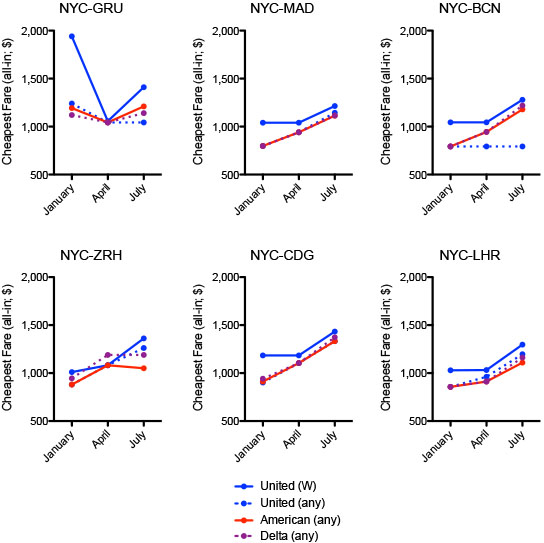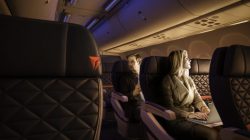One of the key benefits that differentiates top-tier elite status from other tiers is the ability to use systemwide upgrades to move up between cabins on international flights. Sure, other benefits include priority service, free domestic upgrades, and waived fees. But all of those are introduced at lower tiers, too, and the perks you get at the top are just more generous versions. Systemwide upgrades, in contrast, are almost always limited to those who fly over 100,000 miles per year.
But are they actually worthwhile? Today I’ll be analyzing the limitations of these upgrades offered by each of the major airlines and the cost of meeting those requirements.
Systemwide upgrades often have various restrictions on how they must be used. Usually you need to travel on flights operated by the carrier, which means no codeshares. There are a few (rare) exceptions. United will let you request a certificate for use on Lufthansa, but you can’t redeem it until you’re at the gate. You better hope there are still seats left. Delta allows upgrades on KLM and Air France, and while it appears you can request them in advance there is similarly no allowance made for an upgrade wait list.
You also have to worry about how the upgrade is prioritized. Just because there are business or first class seats still for sale doesn’t mean you can get one immediately. They draw from a similar upgrade award space as that used for other award tickets purchased entirely with miles. Fortunately you can sometimes get your upgrade back if it doesn’t clear.
But that’s not what this post is about. Instead, it’s about the fare requirement for redeeming an upgrade. All four U.S. legacy airlines offer them, but they have different rules about which fares they apply to and which routes are eligible. Here’s how many you get from each carrier (note that with Delta, the upgrades are one of several “Choice” options, so you don’t have to pick them–and you’ll see why these might be a bad choice later on).
- United Airlines: Six (6) Global Premier Upgrades for Premier 1K
- Delta Air Lines: Six (6) Systemwide Upgrades for Diamond (on top of 4 after reaching Platinum)
- American Airlines: Eight (8) eVIP Systemwide Upgrades for Executive Platinum
- US Airways: Two (2) Systemwide Upgrades for Chairman’s Preferred
The restrictions on each kind of upgrade also vary.
- United Airlines: Must be used on Y, B, M, E, U, H, Q, V, or W fares from economy to business class and J, C, or D fares from business to first class
- Delta Air Lines: Must be used on Y, B, M, H, Q, or K fares in North America and Y, B, or M fares for trans-oceanic flights
- American Airlines: May be used on any fare
- US Airways: May be used on any fare
To simplify this for you, United requires you to apply the upgrade to a mid-priced economy or business class fare. Delta requires you to apply the upgrade to a nearly full-priced economy fare. This represents a significant premium for United customer over buying the cheapest fare, and for Delta customers it might make more sense just to buy a discounted business class fare.
It’s worth noting that United also provides Regional Premier Upgrades with no fare restrictions that can only be used on mostly domestic flights and a few other shorter international routes with what might be considered a “dumbed down” front cabin experience. The fare class restrictions don’t apply to systemwide upgrades when you use them on the same routes eligible for regional upgrades. So while United’s systemwide upgrades may have many more fare restrictions, elites have a very large number of upgrades overall.
American has removed restrictions but only provides a single pool to draw from. Delta gives you some other “Choice” options, like free miles, so you don’t have to be stuck with their ultra-restrictive systemwide upgrades. US Airways just seems to be playing catch-up, offering only two upgrades but removing the restrictions like American.
So what does it cost to meet these additional fare requirements to use a systemwide upgrade? Let’s rule out Delta for the moment. In the international gateways I examine below, I looked up the cost of an M-fare for several destinations from JFK. In almost all cases it was close to $3,000 with little variation by season. This is rarely a good deal. I recommend most people select the free miles or gifting status to a friend instead. I also didn’t bother checking US Airways at all because of their smaller size and fewer upgrades. The real comparison is between United and American.
I compared the cost of a W fare offered by United to the cheapest economy class fare on United and on American. This provides us two measures: (1) the fare premium a loyal United elite must pay in order to use his or her upgrades rather than just booking the cheapest fare, and (2) the fare premium any passenger has to pay by trying to upgrade with United instead of with American, should he or she be open to changing allegiance. I did this search in three markets where the two airlines have several competitive routes. I also searched for the cheapest Delta fare in New York, where all three compete. (I did a similar analysis earlier this year on fares out of Seattle, and the differences then were much more stark.)
You’ll notice that in almost all cases United’s W fare is higher than the cheapest fare from either United or American. That’s not surprising. But I think data like this is important before choosing where to place your loyalty. Assumptions can be incorrect. You’ll also notice there isn’t much difference between United and American’s cheapest fares. If anything, American is sometimes slightly higher. This tells us that American can save you some money if you plan to redeem an upgrade, but if you fly much more than your upgrades will allow, you’ll be even or possibly save some money with United.
This second figure considers the fare more competitive New York market. I’ve included the cheapest Delta fares just to add more data, but remember that both Delta and United’s cheapest fares don’t qualify for upgrades.
All three airlines have very competitive fares at the cheapest level, sometimes down to the dollar. United’s W fare is generally higher, and sometimes much higher. Finally, let’s take a look at the percentage premium you’ll pay for a W fare with United, compared to both the cheapest United fare and the cheapest American fare. I’ve averaged the premiums in each market.
This gives us some idea of how fares are changing over time. I tried to pick dates far enough in advance that sales and other gimmicks wouldn’t affect the numbers much, so I believe most of what we’re seeing here is the effect of seasonality. I found two interesting things.
First, the flattest variation in premium occurs for flights out of Chicago. Ranging from about 8 to 18%, the larger price you pay to get an upgrade on United doesn’t change much through the first half of the year. But when you look at New York it can be anywhere from 10 to 32%, and in Los Angeles it can be from 8 to 25%. I know that the NYC-GRU fare throws off the numbers a bit, but other destinations from New York also have larger premiums during January, and the are six fares contributing to this average.
Second, I found it odd that the fare premium for United forms a U-curve in New York instead of the steady decline in the Chicago and Los Angeles markets. I’m not sure why this is. The decline you see in other markets might occur because of the higher demand for travel in the peak summer months, so both carriers can raise prices overall. My interpretation is that in New York, United is failing to raise its W fares between January and April, so the premium drops even as the cheapest economy class tickets increase in price.
Graphing data like this helps me determine the best time to use my upgrades. My rule has always been to chase the fare and let sales determine where I go. I might use the data above to determine the best time of year to book an upgradeable fare with United, my preferred carrier, and April looks like a good bet when premiums narrow in several markets. However, for those of you who take regular vacations to certain destinations or at certain times of the year, running the numbers can also tell you if you might be better off shifting your loyalty.







